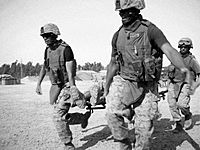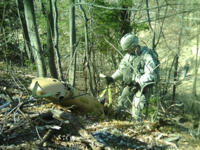Casualty evacuation facts for kids


Casualty evacuation, often called CASEVAC (pronounced KASS-ee-vak), is a military term for quickly moving injured people from a dangerous area, like a battlefield. It can be done by land or air. Sometimes, you'll hear the special radio name Dustoff or Dust Off for these missions. This name is mainly used by U.S. Army helicopter ambulance teams. Today, most air CASEVACs are done by helicopters. This idea started near the end of World War II. Before that, small planes were sometimes used.
Contents
What is CASEVAC?
CASEVAC is all about getting injured people to safety as fast as possible. It's used when someone is hurt and needs to leave a combat zone right away. The main goal is to save lives by moving the injured person quickly to a place where they can get medical help.
CASEVAC vs. MEDEVAC
It's important to know the difference between CASEVAC and medical evacuation (MEDEVAC).
- A MEDEVAC uses special vehicles, like ambulances or helicopters, that are set up like a mini-hospital. They have medical staff and equipment to care for the patient during the trip. These vehicles are also clearly marked with symbols like a red cross, and they are not allowed to carry weapons. Under the Geneva Conventions, attacking a marked MEDEVAC vehicle is a war crime.
- A CASEVAC uses any available vehicle that can get the injured person out quickly. This could be a regular military truck, a transport helicopter, or even a tank. These vehicles might not have medical staff or special equipment on board. They are also allowed to be armed because they are usually used for other military tasks. CASEVACs are often called a "lift of opportunity" because they use whatever is closest and available.
The main idea behind a CASEVAC is speed. If someone is badly hurt and can't wait for a dedicated medical team, any unit with space can help. This could be a Bell Boeing V-22 Osprey or a Sikorsky SH-60 Seahawk helicopter. The focus is on getting the person out of danger immediately.
The Story of "Dust Off"
The famous "Dust Off" radio call sign for medical evacuation started in 1963. It was first used by Major Lloyd E. Spencer, who commanded a U.S. Army helicopter ambulance unit. The name became well-known after a journalist wrote about Major Charles L. Kelly, who took over command from Spencer. Major Kelly died on duty in 1964, and his last words were, "When I Have Your Wounded."
"Dust Off" became the standard call sign for almost all Army medical evacuation units during the Vietnam War and is still used today. These air ambulances often pick up seriously injured soldiers and fly them to a medical facility within an hour. Flying into active combat zones to pick up wounded soldiers was, and still is, a very dangerous job. During the Vietnam War, more than a third of the pilots and crew members on these missions became casualties themselves. Helicopters used for "Dust Off" missions were also lost to enemy fire much more often than other types of helicopters.
Safety and Survival
Today, all members of the U.S. Armed Forces learn basic first aid. Even if a vehicle isn't a dedicated medical transport, soldiers carry an Improved First Aid Kit (IFAK). This kit has important supplies like bandages, a tourniquet (to stop bleeding), and special gauze called QuikClot. Many military vehicles also carry stretchers and burn blankets.
Each military unit also has trained medical professionals, like corpsmen or medics. These experts are skilled in Tactical Combat Casualty Care, which focuses on treating injuries in a combat zone.
The U.S. military has worked hard to make sure there are special MEDEVAC vehicles and trained medical staff available. This effort has greatly improved the chances of survival for injured soldiers. For example, during operations in Afghanistan and Iraq around 2006, the survival rate for casualties was about 90.6%. This is much higher than the 80.9% survival rate during World War II.
CASEVAC Around the World
In the Australian military, the term CASEVAC is used a bit differently. It usually refers to moving a small number of troops, often just one person, from a dangerous area.


